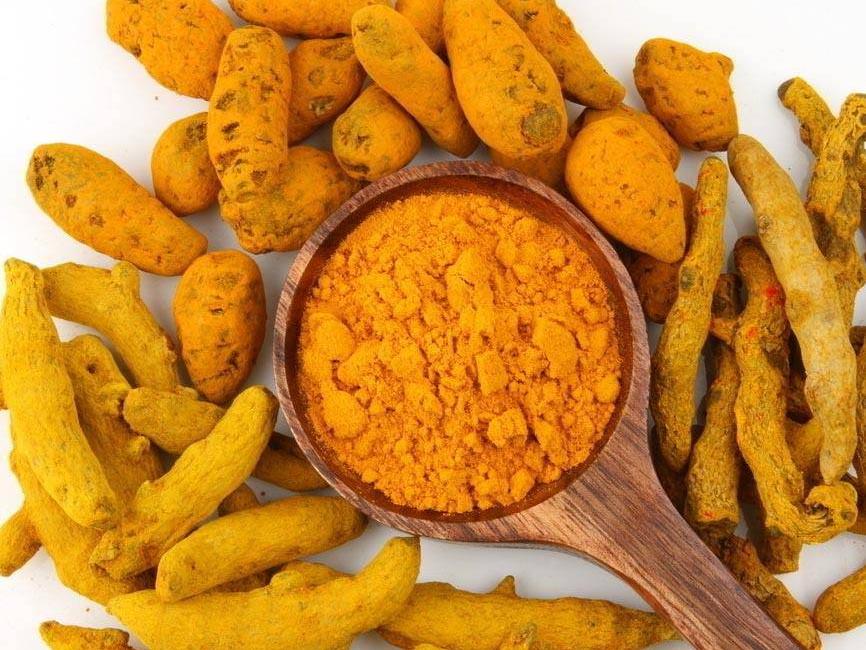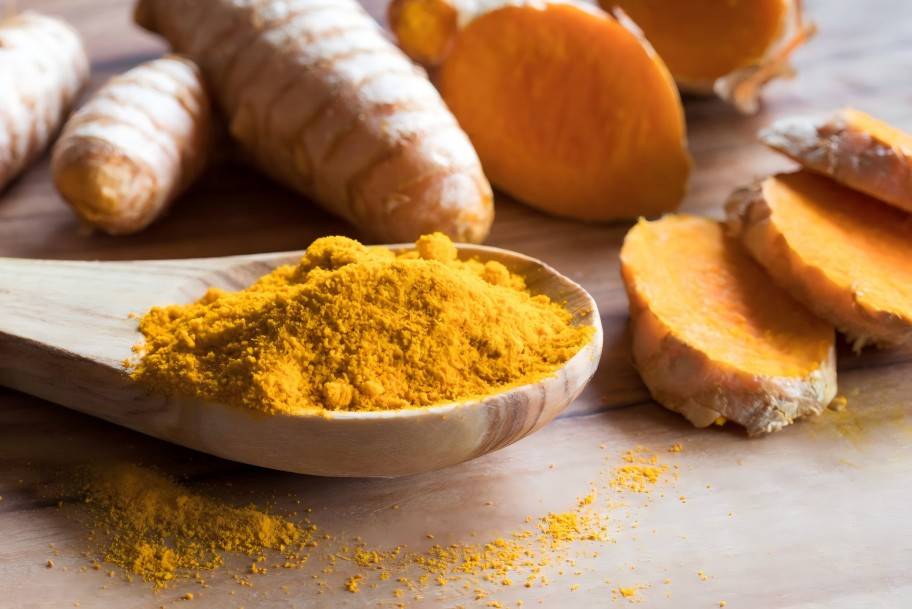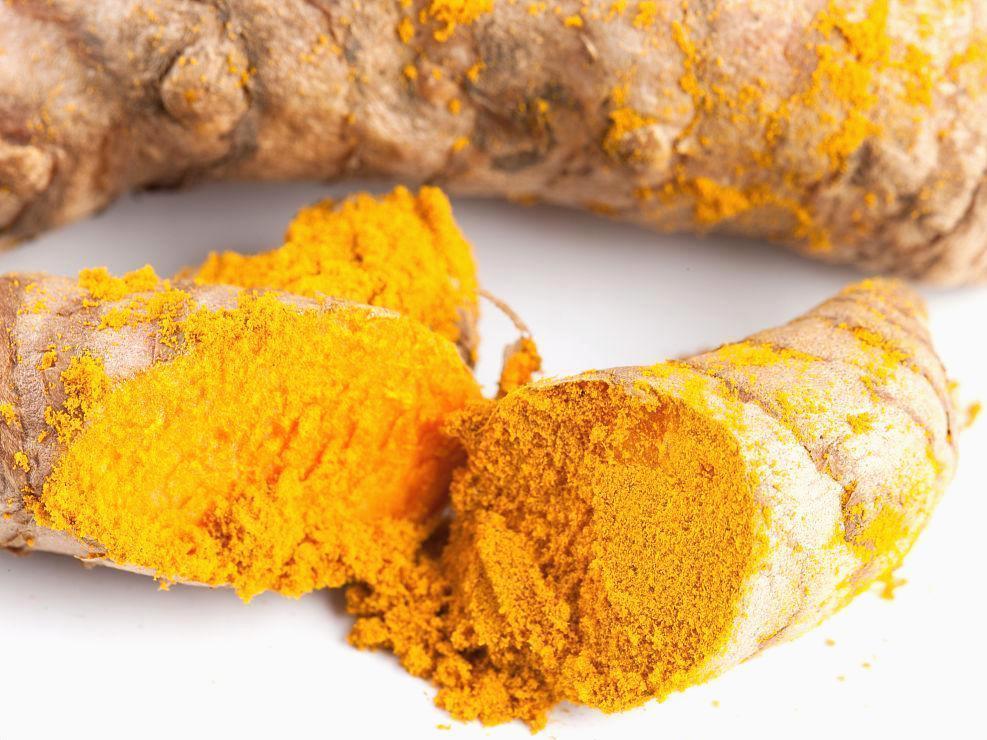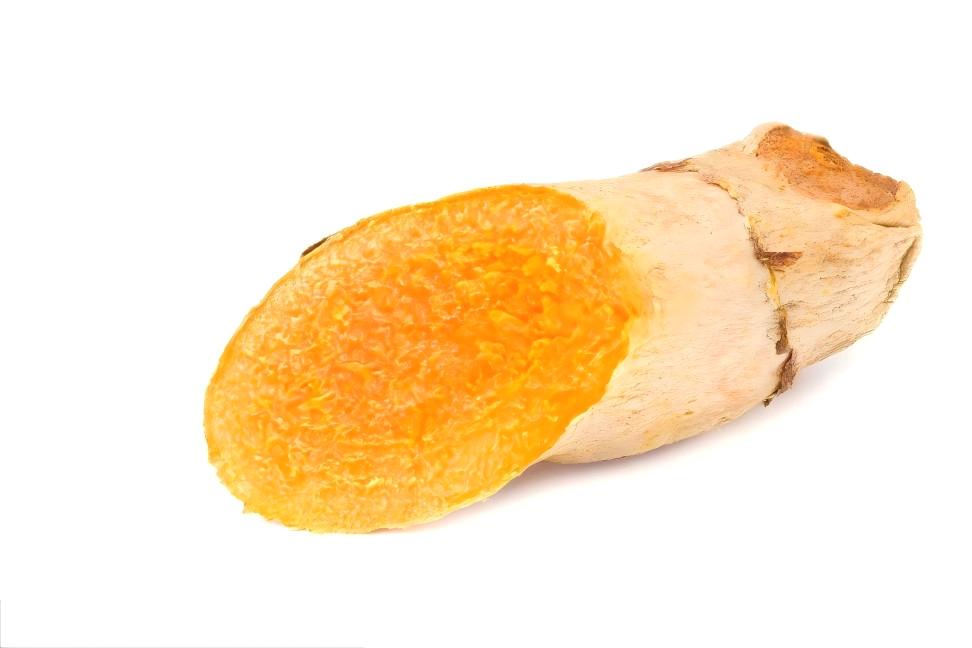Study on Curcumin Anti Inflammatory Benefit
Curcumin is mainly derived from the rhizome of turmeric[1]. In 1870, a low-molecular-weight polyphenol compound called curcumin was first isolated from Curcuma longa L. In 1910, its chemical structure of dihydrokaempferol was clarified, with an unsaturated aliphatic and aromatic group as the main chain. Since then, research on its physiological and pharmacological effects has gradually increased and achieved some progress. pharmacological effects have gradually increased, and some progress has been made.
With the large amount of research and in-depth understanding of curcumin, it has been found to have a variety of biological functions and strong chemopreventive properties. Therefore, curcumin has a wide range of preventive properties against diseases, such as antioxidant, anti-inflammatory, anti-infectious, anticancer, antiviral, anticoagulant, etc. Turmeric extract itself is one of the natural food colors, so it is favored by researchers because of its natural, low-toxicity and safe characteristics. In recent years, modern medical research has shown that the occurrence of many diseases is related to the formation of free radicals and the involvement of inflammatory responses. Turmeric is a natural, highly promising functional substance with health-promoting effects and medicinal activity. Therefore, the antioxidant activity and anti-inflammatory effects of curcumin have gradually attracted widespread attention from scholars at home and abroad [2-3].
Turmeric has a history of at least 200 years as a medicinal plant in China, and curcumin health foods and medicines are widely used in life. The description of turmeric in “Zhonghua Ben Cao” is “bitter, pungent; warm in nature, entering the spleen; liver channel. Breaking blood stasis, promoting Qi circulation, regulating menstruation and relieving pain.” The Chinese Pharmacopoeia states: “It is used for chest and hypochondrium pain, amenorrhea, constipation, rheumatic shoulder and arm pain, and swelling and pain after a fall.” Although turmeric has been used in China for a long time, research into the functional properties of curcumin first originated in India. Research into turmeric in China began in 1975, but the research carried out between 1975 and 2000 was relatively superficial. It was only after 2000 that a large amount of research was carried out into the pathways and mechanisms of curcumin's health and medicinal functions.
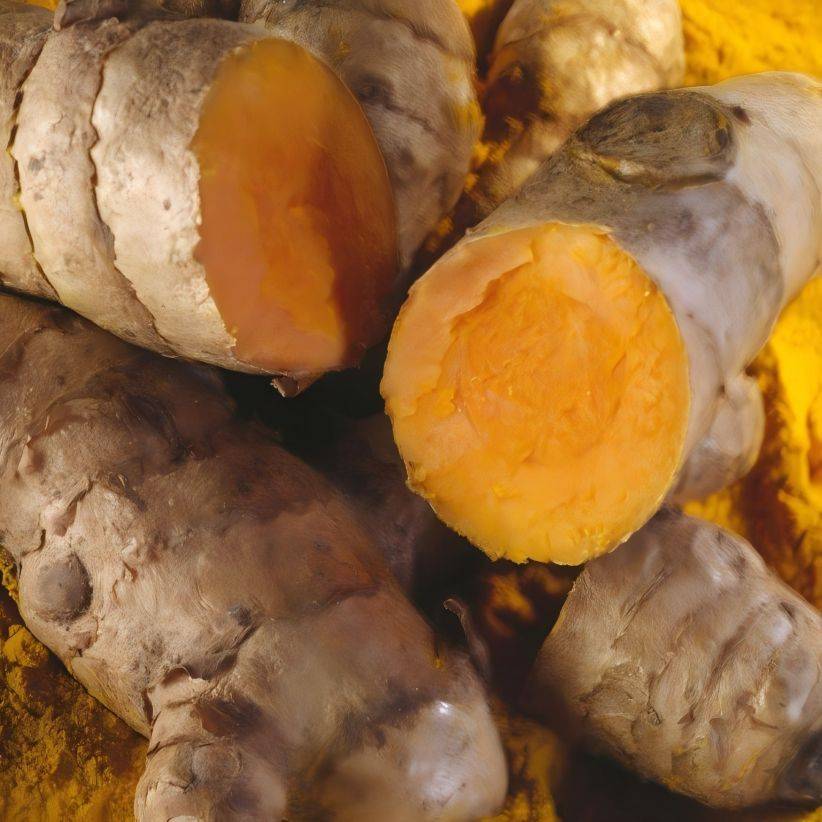
1 Antioxidant effect
Studies have shown that aging and cancer or other diseases are related to the production of excessive free radicals. Research on the antioxidant effect of curcumin in China began in 1996. Shi Jing et al. [4] were the first to study the effect of curcumin on superoxide dismutase (SOD) and malondialdehyde (MDA) levels in mice. After curcumin administration, there was no significant change in MDA levels in the liver of mice, but SOD activity was increased, and the 40 mg/kg group showed a statistically significant increase compared to the control group. The SOD activity in mouse plasma increased, while the MDA content decreased, and the two showed a certain dose-dependent relationship. The mental state and fur luster of the rats in the drug administration group were significantly improved.
Wang Shuran et al. [5-6] mixed curcumin into the feed and fed it to mice, which increased the body's total antioxidant capacity. The optimal dose was 2.5 g/kg of feed. Feeding rats a diet containing curcumin (5 g/kg) for 2 weeks was found to lower blood lipids and increase SOD. Long Mingzhi et al. [7] found that a higher dose (100 mg/kg·d) of curcumin, when administered to New Zealand white rabbits by gavage, had no significant toxic side effects and to some extent inhibited neointimal proliferation after vascular balloon injury. Hu Chunsheng et al. [8] conducted a human food trial on the antioxidant effect of curcumin. The results showed that after the test food was consumed, the serum SOD and glutathione peroxidase (GSH-Px) activity in the test group increased by 5.50% and 6.95%, respectively, and the MDA content in the serum decreased by 1.07%. The study showed that curcumin is highly safe for the human body and has antioxidant effects. Wahlstrom B et al. [9] concluded that curcumin is relatively non-toxic, and animal tests have shown that a high dose of 5 g/kg has no adverse effects on rats. Deodhar S D et al. [10] concluded that it is safe for humans to orally ingest 1,200 mg/kg of curcumin per day. As a relatively safe free radical scavenger, the application value of curcumin in anti-aging needs to be further developed.
The later stages of research into the antioxidant effects of curcumin focused on the pathways and mechanisms involved. Yang Kaiyan et al. [11] used curcumin to pretreat the microglial cell line BV and stimulated it with lipopolysaccharide (200 ng/mL). The results showed that lipopolysaccharide could activate microglial cells, significantly enhancing the gene expression of iNOS and NF-κB; the expression of iNOS protein was significantly increased, NO release increased; intracellular SOD and GSH-Px activity significantly decreased, while curcumin (10 μmol/L) can significantly inhibit the production of NO, the expression of iNOS protein, and the expression activity of iNOS-Luc and NF-κB-Luc in activated microglia. the mechanism may be through the NF-κB signal transduction pathway to inhibit iNOS expression,curcumin can exert an anti-oxidant effect by increasing the activity of intracellular SOD and GSH-Px. Siddiqui A M [12], Blanquicett C [13], Kang Q et al [14] have verified that curcumin can reduce the expression of PPAR-γ and the activity of PPAR by inhibiting redox transcription factors. or activate the PPAR-γ protein to relieve oxidative stress. Li Ke [15] demonstrated that curcumin can protect rod cells by inducing HO-1 expression and reducing oxidative stress. Wang Ning [16] found that curcumin can relieve oxidative stress damage to human umbilical vein endothelial cells by inhibiting the Notch signaling pathway.
With regard to the pathways and mechanisms of the antioxidant effect of curcumin, a large number of studies at home and abroad have shown that curcumin can recognize each other with signal transduction molecules, and then convert and transmit signals. In different signal transduction pathways, it can induce the production of antioxidant enzymes by up-regulating or down-regulating the expression of related genes, thereby improving oxidative stress, exerting an antioxidant effect, and ultimately achieving the purpose of preventing and treating diseases.
2 Anti-inflammatory effect
Inflammation is the cause and manifestation of most chronic diseases. Anti-inflammatory drugs are often used in treatment to prevent or treat inflammation. Steroidal and non-steroidal anti-inflammatory drugs are commonly used and effective in treating inflammatory diseases, but they can have side effects. Studies have found that curcumin has anti-inflammatory activity and anti-inflammatory effects similar to steroids and non-steroidal drugs such as indomethacin and phenylbutazone, and in most cases has fewer side effects and is highly safe. Domestic research on the anti-inflammatory effects of curcumin began in 1992. There are many types of inflammation, including bronchitis, rheumatism, neurodegenerative diseases, allergies, diabetes, asthma, and enteritis.
Chen Jing et al. [17] found in their research on curcumin and Parkinson's disease that 20 μmol/L curcumin can inhibit the decrease in PC12 cells caused by 1-methyl-4-phenylpyridinium (MPP+) and the increase in intracellular ROS content, indicating that curcumin can inhibit MPP+-induced PC12 cell apoptosis. and its mechanism of action may be related to maintaining mitochondrial membrane potential, stabilizing mitochondrial function and scavenging ROS. Chen Guizhi, Jian Yanting and others [18-19] explored the protective effect of curcumin on rat colitis and its mechanism, and found that curcumin can significantly inhibit the high expression of the pro-inflammatory factor IL-1β mRNA in the intestinal mucosa of rats with colitis model, while significantly increasing the low expression of the anti-inflammatory factor IL-10 mRNA. Morphologically, the intestinal tissue and histological scores improved significantly. Tao Zhengxian et al. [20] found that curcumin can significantly reduce the levels of insulin and blood lipids in the serum of diabetic rats. Its mechanism of action may be to inhibit the expression of vascular cell adhesion molecule-1 (ICAM-1) mRNA and improve vascular endothelial function.
Zhao Huijuan et al. [21] confirmed that curcumin can significantly reduce the levels of plasma TNF-α and serum sICAM-1 in rats with metabolic syndrome, regulate insulin levels, and prevent or delay the occurrence of atherosclerosis. Rechtman M M et al. [22] studied curcumin as a specific drug for the treatment of hepatitis B virus infection. The results showed that curcumin can down-regulate the hunger-induced protein PGC-1α, activate the gluconeogenic cascade to activate hepatitis B virus transcription, thereby inhibiting hepatitis B virus gene expression and replication.
Ali S O et al. [23] showed that curcumin can alleviate chronic hepatitis by inhibiting the production of oxidative stress and inflammatory factors. Wang Jianjun et al. [24] studied the effect of curcumin on airway inflammation and nuclear factor-κB in rats with bronchial asthma. It was found that the infiltration of peribronchial inflammatory cells in the asthma model group was significantly reduced in the curcumin group. There was no obvious infiltration of inflammatory cells in the normal control group, indicating that curcumin has an inhibitory effect on chronic airway inflammation, This effect may be related to the inhibition of NF-κB expression. Zhao Xuan et al. [25] used a modular network analysis method to study the anti-inflammatory mechanism of curcumin and ultimately found that the anti-inflammatory mechanism of curcumin may be related to the SMAD protein family, the ERG protein family and TLR regulation, and that TLR9 may be a potential target of curcumin's anti-inflammatory effect.
As a purely natural substance, curcumin has shown high efficacy and safety in the treatment of inflammation and its mediated diseases (such as neurological diseases, diabetes, rheumatoid arthritis, etc.). Its anti-inflammatory mechanism of action may be through the inhibition of COX-2, LOX, iNOS, cytokine products (such as INF-γ, TNF) and other transcription factors (such as NF-κB). In the past two years, research has found that curcumin can regulate the activity of corticosteroids in inflammatory responses, which is a new target for anti-inflammatory effects. In order to clarify the structure-activity relationship of curcumin, domestic and foreign scholars have designed and synthesized a large number of curcumin structural derivatives and analogues based on curcumin, in order to discover more efficient new curcumin drugs to treat inflammation and better serve human health.
3 Anti-cancer effects
Curcumin has multiple molecular targets, so the pharmacological effects and molecular mechanisms of curcumin and its derivatives are different. Different derivatives have different biological activities in cells, tissues and specific organs. Curcumin has potential anti-cancer properties against digestive system cancers (esophagus, stomach, intestines, liver, pancreas, colon), urinary tract cancers (bladder, kidney, prostate), reproductive system cancers (cervical cancer, ovaries, uterus), blood system cancers (leukemia, lymphoma, multiple myeloma), lung cancer, etc. Research on the anti-tumor and anti-cancer effects of curcumin began in 1998.
3.1 Anti-lung cancer research
He Cong, Xu Jinhong, Zhou GZ et al. [26-29] found that curcumin can inhibit cell activity through autophagy and promote apoptosis of lung cancer cells. Chen Q, Qin Fang, Yang Qinmei et al. [30-32] found that curcumin can regulate the changes of microfilament skeleton, thereby promoting the growth and apoptosis of lung cancer cells. Guan Zhonghai and Wang Congcong et al. [33-35] found that curcumin can inhibit angiogenesis in lung cancer cells.
3.2 Anti-liver cancer research
Many scholars have used curcumin to study the prevention, treatment and cure of liver cancer. Li Shuaishuai, Jiang Jinhuan and others [36-37] found that curcumin can inhibit the growth and proliferation of liver cancer cells by inhibiting the expression of mRNA and protein or regulating the expression of cell proteins. Xie Yongjin and Wei Min et al. [38-39] found that curcumin can inhibit the growth of cancer cells by reducing the expression of vascular endothelial growth factor (VEGF), reducing microvascular density (MVD), reversing the drug resistance of Hep G2/ADM cells, and increasing the sensitivity of these cells to chemotherapy, thereby to achieve the goal of preventing and treating liver cancer.
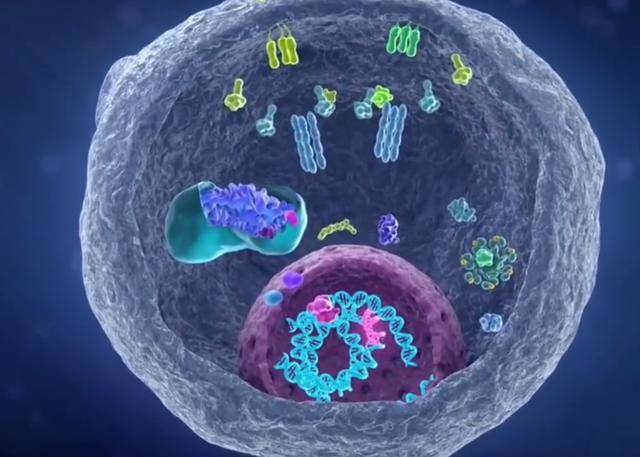
3.3 Research on anti-reproductive cancer
Liu Dongju et al. [40] found that curcumin may play a role in preventing cervical cancer lymphatic metastasis by reducing the expression of macrophage migration inhibitory factor (MIF) and vascular endothelial growth factor-C (VEGF-C) in nude mouse tumors transplanted with human cervical cancer Caski cells. Li Ji et al. [41] found that curcumin can inhibit the expression of Bcl-xL and Bcl-2 to promote apoptosis of tumor cells, while reducing the expression of Eph A2 and Ephrin A1 to reduce tumor microvascular formation, and has significant antitumor and radiotherapy sensitization effects. Poma P, Labbozzetta M et al. [42-43] found that curcumin may induce apoptosis in breast cancer cells through both estrogen-dependent and non-estrogen-dependent mechanisms. Lin L, Shishodia S et al. [44-45] found that curcumin can inhibit the matrix metalloproteinase family, which is related to its ability to inhibit matrix degradation and thus inhibit angiogenesis in breast tumors. Curcumin can also affect the adhesion between tumor cells and the expression of genes by blocking signal transduction in tumor cells.
Ding Jiao, Li Fan and others [46-47] found that curcumin can reduce the density of microvessels, promote angiogenesis and increase apoptosis of tumor cells. Peng D, Liang R et al. [48-49] showed that curcumin may inhibit the growth of human ovarian cancer cells by inhibiting protein expression or reversing multidrug resistance by inhibiting the expression of genes in human ovarian cancer, thus inhibiting the growth of human ovarian cancer cells and having an anti-tumor effect.
3.4 Anti-urogenital cancer research
Sahus R P, Tian B, Chadalapaka G et al. [50-52] found that curcumin can induce proteasome-related down-regulation and reduce the expression of vascular endothelial growth factor and its receptors, thereby inhibiting the growth of bladder cancer cells. Wang Jingyu, Li Qian, Qiu Wei and others [53-55] found that curcumin can significantly inhibit the proliferation of bladder cancer cells and promote apoptosis of tumor cells by activating autophagy. It can also inhibit the activation of cancer cell signal pathways, stimulate the expression of various pro-apoptotic molecules, and thereby induce apoptosis of cancer cells. Li Gang, Gao Jinsheng and others [56-57] found that curcumin promotes apoptosis of renal cancer cells by inhibiting the expression of anti-apoptotic proteins and upregulating the expression of pro-apoptotic proteins. Jiang Yanni, Zhang Tao and others [58-59] found that the mechanism by which curcumin inhibits the growth of renal cancer cells may depend on protein signaling pathways or be related to gene transcription pathways. Sundram V, Cimino S, et al. [60-61] showed that curcumin can reduce the proliferation, aggregation and cell viability of prostate cancer cells through the activation of protein kinases, enhance cell-cell aggregation, and inhibit nuclear transcription of cancer cells. In vivo test results also showed that the inhibitory effect on tumor growth is related to the inhibition of nuclear transcription activity and the enhanced effect of membrane localization. Qi Ruifang, Mukhopadhyay A and others [62-63] found that curcumin can reduce the migration and invasion of prostate cancer cells, which is related to the down-regulation of anti-apoptotic genes, thereby inducing apoptosis of renal cancer cells.
The anti-cancer mechanism of curcumin is divided into two levels: one is the cellular level, where treating tumor cells with curcumin can exert an anti-cancer effect by promoting apoptosis, inhibiting cell proliferation, anti-angiogenesis, and inhibiting invasion and metastasis; the other is the overall level, where the effect of curcumin on tumors is mainly reflected in the regulation of epigenetics and immune editing.
3.5 Other diseases
In addition to its antioxidant, anti-inflammatory and anticancer biological functions, curcumin is also effective in preventing cardiovascular disease. Studies have shown that curcumin has a protective effect on cardiovascular disease by inhibiting heart failure, cardiovascular complications of diabetes, atherosclerosis, myocardial hypertrophy, aneurysms and myocardial infarction [64-66]. Curcumin also has a good effect on organ fibrosis [67-69]. For lesions of different organs, it exerts anti-fibrosis function through different pathways. At present, it is mainly manifested in anti-hepatic fibrosis, anti-cardiac fibrosis, anti-renal fibrosis and anti-pulmonary fibrosis, and this function is also widely used in clinical treatment.
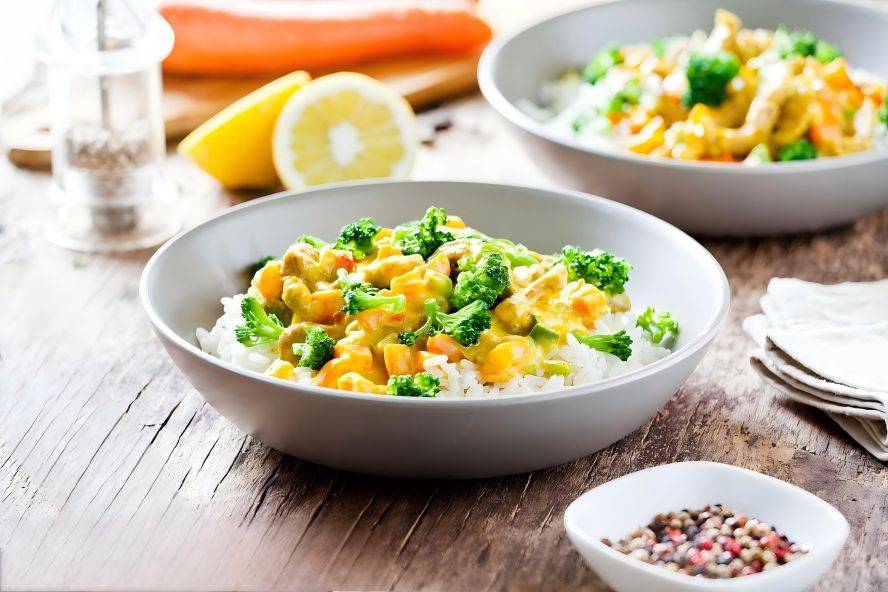
4 Conclusion
The health-promoting functions and pharmacological effects of the plant-derived natural drug curcumin are gradually being discovered. Although research at the cellular level, in animal experiments and in the clinic has been carried out relatively comprehensively, the mechanism of action of curcumin in the prevention and treatment of various diseases is still not fully understood. Moreover, the bioavailability of curcumin is relatively low, and its application is therefore somewhat limited. Studies have found that structural modification of curcumin results in the synthesis of many derivatives with better bioavailability and better pharmacokinetic and pharmacodynamic characteristics. However, at present, there is a lack of relevant toxicological data on curcumin derivatives with structural modifications in practical applications, and further research is needed. However, with the multi-dimensionalization of cell culture systems, the maturation and application of new research methods such as simulated culture platforms, organoid models, and human tumor xenograft models, the research on the inhibitory mechanism of curcumin against various diseases will surely be promoted.
Reference:
[1] Henrotin Y ,Gharbi M ,Dierckxsens Y ,et al.Decrease of a specific biomarker of collagen degradation in osteoarthri- tis , Coll2 -1 , by treatment with highly bioavailable curcumin during an exploratory clinical trial [J] .BMC Com- plementary Altern Med ,2014 , 14(1): 159-164.
[2] Amalraj A ,Pius A , Gopi S ,et al.Biological activities of curcu-minoids ,other biomolecules from turmeric and their derivatives :A review [J] .J Tradit Complement Med ,2017(2): 205-233.
[3]Yang Q , Wu S , Mao X , et al.Inhibition effect of cur- cumin on TNF-α and MMP-13 expression induced by ad- vanced glycation and products in chondrocytes [J] .Phar- macology ,2013(1/2): 77-85.
[4] Shi Jing, Tao Yi, Tian Yaping. Effects of curcumin on SOD activity and MDA content in rats [J]. Chinese Journal of Pharmacology, 1997(3): 183-187.
[5] Wang Shuran, Chen Bingqing, Wang Chaoxu, et al. Study on the hypolipidemic and antioxidant effects of curcumin [J]. Chinese Journal of Public Health, 1999 (5): 263-265.
[6] Wang Shuran, Chen Bingqing, Sun Changhao. Study on the regulation of blood lipids and antioxidant effects of curcumin in rats [J]. Health Research, 2000 (4): 240-242.
[7] Long Mingzhi, Chen Leilei, Yang Jiming, et al. Anti-inflammatory and antioxidant effects of curcumin and its effect on vascular injury and intimal hyperplasia [J]. Jiangsu Medicine, 2003(10): 735-737.
[8] Hu Chunsheng, Chen Weilin, Yi Chuanzhu, et al. Antioxidant effect of curcumin: a human trial study [J] . Journal of Hunan University of Traditional Chinese Medicine , 2007 (5): 63-64.
[9] Wahlstrom B, Blennow G. A study on the fate of curcumin in the rat [J]. Acta Pharmcol Toxicol, 1978 (1): 86-92.
[10] Deodhar S D, Sethi R, Srimal R C. Preliminary study on antirheumatic activity of curcumin [J]. Indian J Med Res, 1980(7): 632-634.
[11] Yang Kaiyan, Gu Jianlan, Yin Dongmei, et al. Inhibition of iNOS expression and antioxidant effect of curcumin on lipopolysaccharide-activated microglia [J]. Chinese Journal of Biochemistry and Molecular Biology, 2007(11): 938-945.
[12] Siddiqui A M ,Cui X ,Wu R ,et al.The anti-inflammato- ryeffect of curcumin in an experimental model of sepsis is- mediate d by up-regulation of peroxisome proliferator-acti- vated receptor-γ [ J] .Crit Care Med , 2006 , 34(7): 1 874-1 882.
[13] Blanquicett C , Kang B Y , Ritzenthaler J D , et al. Oxi - dativestress modulates PPARγ in vascular endothelial cells [J] .Free Radic Biol Med ,2010 ,48(12): 1 618-1 625.
[14] Kang Q , Chen A.Curcumin eliminates oxidized LDL roles in activating hepatic stellate cells by suppressinggene ex-pression of lectin-like oxidized LDL receptor-1 [ J] . Lab Invest ,2009(11): 1 257-1 290.
[15] Li Ke. Protective effect and mechanism of curcumin on alcohol-induced liver cell damage [D]. Wuhan: Huazhong University of Science and Technology, 2006.
[16] Wang Ning. Study on the mechanism of curcumin antagonizing oxidative stress damage in vascular endothelial cells mediated by Notch1 pathway [D]. Xi'an: Fourth Military Medical University, 2014.
[17] Chen Jing, Tang Xiaoqing, Hu Zhiping, et al. The effect of curcumin MPP on the induction of PC12 cell apoptosis [J]. Chinese Journal of Pharmacology, 2005, 21(3): 335-339.
[18] Chen Guizhi, Luo Lidan, Qin Lingzhi, et al. Effects of curcumin on ulcerative colitis in rats [J]. Journal of Xianning University (Medical Sciences), 2006 (4): 298-301.
[19] Jian Yanting, Wang Jide, Mai Guofeng, et al. Curcumin regulates inflammatory factors in the intestinal mucosa of model rats [J]. Journal of the First Military Medical University, 2004, 24(2): 1353-1355.
[20] Tao Zhengxian, Long Mingzhi, Zhao Huijuan, et al. Effect of curcumin on ICAM-1 and related serum indicators in rats with metabolic syndrome [J]. Journal of the Fourth Military Medical University, 2006 (24): 2291-2293.
[21] Zhao Huijuan, Tao Zhengxian, Long Mingzhi, et al. Effects of curcumin on plasma TNF-α and serum ICAM-1 levels in rats with metabolic syndrome [J]. Chinese Journal of Rehabilitation Medicine, 2006(7): 599-601.
[22] Rechtman M M ,Har Noy O ,Bar Yishay I ,et al.Curcu- min inhibits hepatitis B virus via down -regulation of the metabolic coactivator PGC -1α [ J] .FEBS Letters , 2010(11): 2 485-2 490.
[23] Ali S O , Darwish H A,Ismail N A. Curcumin , silybin- phytosome and α-r-lipoic acid mitigate chronic hepatitis in rat by inhibiting oxidative stress and inflammatory cytokines production [J] .Basic Clin Pharmacol Toxicol,2015
(12): 430-438.
[24] Wang Jianjun, Wang Sanping, Xiong Haijin, et al. Effect of curcumin on airway inflammation and nuclear factor-κB expression in asthmatic rats [J]. Chinese Journal of Clinical Rehabilitation, 2005 (15): 102-106.
[25] Zhao Xuan, Fu Chaomei, Gan Yanxiong, et al. Research on the anti-inflammatory mechanism of curcumin based on network pharmacology [J]. Chinese Medicine and Clinical Practice, 2015 (4): 58-62.
[26] He Cong, Chen Qingyong, Wang Jian, et al. Study on the downregulation of mTOR by curcumin to induce autophagy in human lung cancer A549 cells [J]. Journal of Oncology, 2014(5): 363-368.
[27] Xu J H. Study on the effect and mechanism of curcumin-3 on EMT of highly metastatic non-small cell lung cancer cells [D]. Chongqing: Third Military Medical University, 2015.
[28] Zhou G Z , Sun G C , Zhang S N.Curcumin derivative HBC induces au -tophagy through activating AMPK signal in A549 cancer cells [J] .Molecular & Cellular Toxicology, 2015(1): 29-34.
[29] Zhou G Z , Sun G C , Zhang S N.The interplay between autophagy andapoptosis induced by one synthetic curcumin derivative hydrazino-benzoylcurcumin in A549 lung cancer cells [J] . Journal of biochemical and molecular toxicology, 2015 ,29(6): 267-273.
[30] Chen Q ,Zheng Y ,Jiao D , et al. Curcumin inhibits lung cancer cell migration and invasion through Rac1-dependent signaling pathway [J] .The Journal of Nutritional Biochem- istry ,2014 ,25(2): 177-185.
[31] Qin Fang, Qin Shuying, Wang Xinsen, et al. Mechanism of curcumin inhibiting proliferation and promoting apoptosis of human non-small cell lung cancer A549 cells by upregulating miR-15a/16 expression [J]. Chinese Journal of Gerontology, 2019 (22): 5615–5620.
[32] Yang QM, Cui QR, Li B, et al. Effects of curcumin on the proliferation and apoptosis of lung cancer stem cells by regulating the Notch signaling pathway [J]. Modern Oncology, 2018, 26(20): 3199-3204.
[33] Guan Zhonghai. Research on individualized anti-tumor treatment of vascular targeted drugs based on intestinal cancer PDX model [D]. Hangzhou: Zhejiang University, 2017.
[34] Wang Congcong, Zhuang Jing, Feng Fubin, et al. Discussion on the mechanism of curcumin inhibiting the formation of vascular mimicry in lung cancer cells [J]. Chinese Journal of Cancer Prevention and Treatment , 2015 (4): 243-246.
[35] Wang Congcong, Zhuang Jing, Lv Qingliang, et al. Curcumin capsules combined with radiotherapy for the treatment of 29 cases of non-small cell lung cancer brain metastases [J]. Liaoning Journal of Traditional Chinese Medicine , 2015 (5): 996-998.
[36] Li Shuaishuai, Sun Jun. Study on the effect of curcumin on the expression of cyclooxygenase-2 in human liver cancer cells BEL-7402 [J]. Journal of China Medical University, 2014(13): 222-225.
[37] Jiang Jinhuan. Study on the induction of apoptosis in human liver cancer HepG2 cells by curcumin targeting the microtubule cytoskeleton [D]. Guangzhou: Jinan University, 2013.
[38] Xie Yongjin, Wei Bin, Chen Yueda, et al. Experimental study on the treatment of curcumin on mouse liver cancer transplanted tumors [J]. Chinese Medicine Bulletin , 2015 (2): 66-69.
[39] Wei Min, Zhang Yangde, He Jiantao. Experimental study on curcumin reversing drug resistance of liver cancer [J]. Chinese Journal of Modern Medicine, 2008 (17): 2441-2443.
[40] Liu Dongju, Yao Yu. The effect of curcumin on the expression of MIF and VEGF-C in human cervical cancer Caski cell nude mouse transplant tumors [J]. Oncology Foundation and Clinical, 2016 (1): 10-14.
[41] Li Ji, Zou Bofeng, Wang Yuanhe, et al. Effects of curcumin on the expression of Bcl-xL, Bcl-2, Eph A2 and Ephrin A1 in patients with advanced cervical cancer [J]. Modern Biomedicine, 2016 (7): 1314-1318.
[42] Poma P,Notarbartolo M,Labbozzetta M , et al.The antitumoractivities of curcumin and of its isoxazole analogue are notaffected by multiple gene expression changes in an MDR modelof the MCF-7 breast cancer cell line :Analysis of the possiblemolecular basis [J] . Int J Mol Med , 2007, 20(3): 329-335.
[43] Labbozzetta M ,Notarbartolo M ,Poma P ,et al. Curcumin as apossible lead compound against hormone-independent, multidrug-resistant breast cancer [J] . Ann N Y Acad Sci, 2009 ,55(11): 278-283.
[44] Lin L ,Hutzen B ,Ball S ,et al.New curcumin analogue- sexhibit enhanced growth -suppressive activity and inhibit AKT and signal transducer and activator of transcription 3 phosphorylation in breast and prostate cancer cells [ J] . CancerSci ,2009(9): 1 719-1 727.
[45] Shishodia S , Chaturvedi M M , Aggarwal B B.Role of curcumin incancer therapy [J] . Curr Probl Cancer ,2007, 31(4): 243-305.
[46] Ding J. Effects of curcumin on the proliferation and apoptosis of human ovarian cancer Skov3 cells and Hes-1 gene expression [D]. Nanchang: School of Medicine, Nanchang University, 2013.
[47] Li Fan, Ma Xiangdong, Chen Bilang, et al. Curcumin blocks NF-κB signaling pathway to inhibit the proliferation of human ovarian cancer cell line 3AO [J]. Modern Oncology, 2010 (6): 1077-1080.
[48] Peng D, Qing J, Qi Y, et al. Curcumin inhibits the proliferation of a mouse transgenic ovarian cancer cell line and its relationship with the p21/BRCA1 signaling pathway. Modern Oncology, 2012(10): 2022-2027.
[49] Liang Ruojia, Jiang Xuelu, Yao Qinghua, et al. Study on the reversal of P-gp-mediated multidrug resistance in ovarian cancer by curcumin [J]. Chinese Family Medicine, 2014, 12(6): 932-934.
[50] Sahus R P , Batra S , Srivastava S K. Activation of ATM/ Chkl by curcumin causes cell cycle arrest and apopto- sis in human pancreatic cancer cells [J] . Br J Can- cer ,2009(9): 1 425-1 433.
[51] Tian B , Wang Z , Zhao Y , et al. Effects of curcumin on bladder cancer cells and development of urothelial tu- mors in a rat bladder carcinogenesis model [J] . Cancer Lett ,2008(2): 299-308.
[52] Chadalapaka G ,Jutooru I , Chintharlapalli S , et al. Cur- cumin decreases specificity protein expression in bladder cancer cells [J] . Cancer Res , 2008 , 68(13): 5 345 - 5 354.
[53] Wang Jingyu, Wang Zhiping, Zhao Junli, et al. Curcumin induces bladder cancer EJ cell apoptosis by acting on the PTEN/PI3K/AKT pathway [J]. Pharmacology and Clinical of Traditional Chinese Medicine, 2011 (1): 26-28.
[54] Li Qian, Su Yu, Chen Yajuan, et al. Curcumin's effect on the in vitro invasion of human bladder cancer cell line T-
(24) [J]. Journal of Beihua University (Natural Science Edition), 2015 (2): 203-205.
[55] Qiu Wei, Shen Yongqing, Ni Xiaochen. Curcumin activates autophagy in human bladder cancer T24 cells to induce apoptosis [J]. Hebei Medicine, 2015(20): 3 054- 3 057.
[56] Li Gang, Wang Zi-Ming, Zhong Tie. Sensitizing effect of curcumin on radiation of human renal cancer ACHN cells and its mechanism [J]. Journal of Xi'an Jiaotong University (Medical Sciences), 2011(3): 299-302.
[57] Gao Jinsheng, Li Yusong, Liu Likun, et al. Effects and mechanisms of curcumin on the growth and apoptosis of human renal cancer Caki-2 cells [J]. Liaoning Journal of Traditional Chinese Medicine, 2015(9): 1730-1733.
[58] Jiang Yanni, Shao Hongwei, Tan Yuhui, et al. Study on the induction of G2/M phase block in renal cancer 786-O cells by curcumin and its molecular mechanism [J]. Chinese Medicine New Drugs and Clinical Pharmacology, 2015 (4): 460-463.
[59] Zhang Tao, Zhou Jie, Chen Min, et al. Curcumin promotes the apoptosis of human renal cancer cells through the PPAR-γ pathway [J]. Modern Journal of Urology, 2013 (1): 13-18.
[60] Sundram V , Chauhan S C , Ebeling M , et al. Curcumin attenuates β -catenin signaling in prostate cancer cells through activation of protein kinase Dl [J] . PloS One, 2012(4): 353-368.
[61] Cimino S , Sortino G , Favilla V ,et al. Polyphenols: Key issues involved in chemoprevention of prostate cancer [J] . Oxid Med Cell Longev ,2012(12): 632-639.
[62] Qi Ruifang, Yu Xiaoling, Zhao Hui. Inhibitory effect of curcumin on the migration of prostate cancer PC3 cells and its effect on the expression of MMP2 in vitro and in vivo [J]. Chinese Journal of Basic Medicine in Traditional Chinese Medicine, 2015 (11): 1398-1400.
[63] Mukhopadhyay A , Bueso -Ramos C , Chatterjee D , et al. Curcumin downregulates cell survival mechanisms in human prostate cancer cell lines [J] . Oncogene ,2001 , 52(20):7 597-7 609.
[64] Mir O , Ropert S , Chamseddine A N , et al. Curcumin dietary supplements and everolimus-based cancer treatment [J] .Ann Oncol ,2018 ,29(1): 287-288.
[65] Panahi Y ,Ahmadi Y ,Teymouri M ,et al.Curcumin as a potential candidate for treating hyperlipidemia :A review of cellular and metabolic mechanisms [ J] . J Cell Physiol, 2018(1): 141-152.
[66] Momtazi -Borojeni A A , Abdollahi E , Nikfar B , et al. Curcumin as a potential modulator of M1 and M2 macrophages: New insights in atherosclerosis therapy [J] . Heart Fail Rev ,2019 ,24 (3): 399-409.
[67] Chauhan P S , Dash D , Singh R. Intranasal curcumin in- hibits pulmonary fibrosis by modulating matrix metallopro- teinase-9(MMP-9) in ovalbumin-induced chronic asthma [J] . Inflammation ,2017 ,40(1): 248-258.
[68] Zhao X G , Chen G M , LIU Y , et al. Curcumin reduces Ly6Chi monocyte infiltration to protect against liver fibrosis by inhibiting Kupffer cells activation to reduce chemokines secretion [ J] .Biomed Pharmacother , 2018, 106: 868 - 878.
[69] Huang R , Liu Y , Xiong Y L , et al. Curcumin protects against liver fibrosis by attenuating infiltration of Gr1hi monocytes through in hibition of monocyte chemoattractant protein-1 [J] . Discov Med ,2016(21): 447-457.


 English
English French
French Spanish
Spanish Russian
Russian Korean
Korean Japanese
Japanese